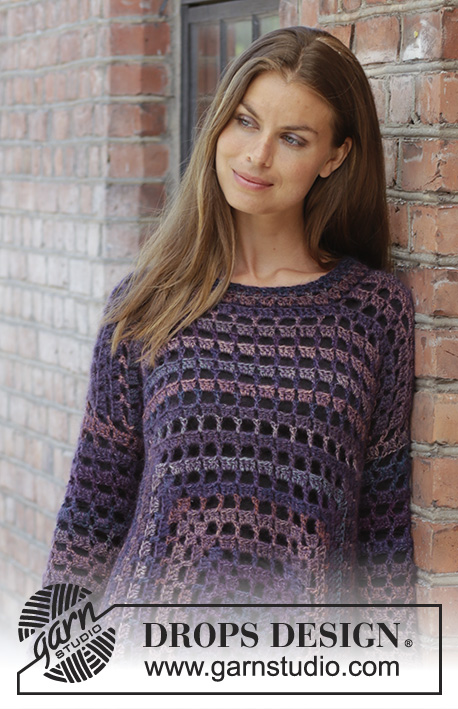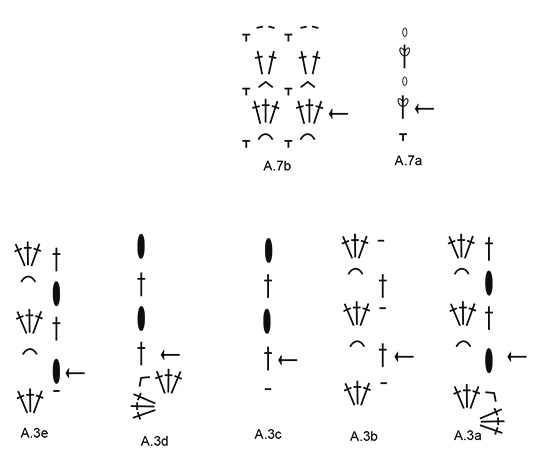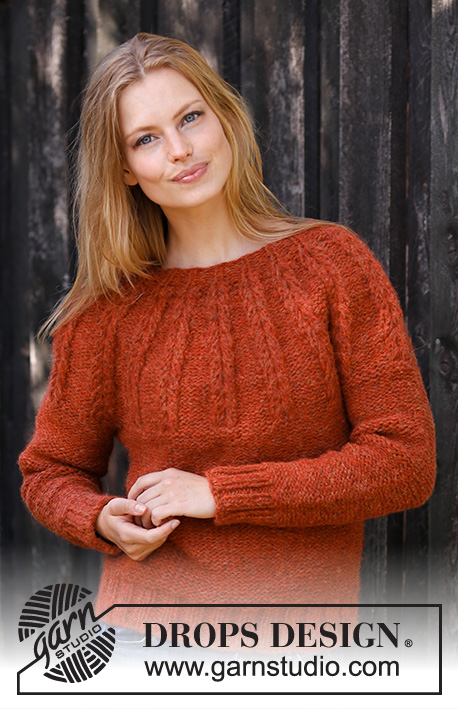Comments / Questions (26)
![]() MARIA CRISTINA RUCCI wrote:
MARIA CRISTINA RUCCI wrote:
Buona sera, sto facendo il modello 197-31 , sono arrivata al bordo dello scollo. Non capisco che significa nel giro 1: Saltare la prima riga. Grazie
19.02.2024 - 17:44DROPS Design answered:
Buongiorno Maria Cristina, deve affiancare il lavoro nella cucitura delle spalla e lavorare sul davanti, saltando la prima riga che incontra. Buon lavoro!
21.02.2024 - 08:54
![]() MARIA CRISTINA RUCCI wrote:
MARIA CRISTINA RUCCI wrote:
Grazie mille per l'aiuto che mi avete dato. Mi scuso per avervi richiesto nuovamente la risposta, ero molto ansiosa di andare avanti con il lavoro e la vostra è arrivata quasi contemporaneamente alla mia richiesta . Di nuovo grazie e se avrò ancora bisogno, mi permetterò di scrivervi. Buona serata
03.02.2024 - 19:46
![]() MARIA CRISTINA RUCCI wrote:
MARIA CRISTINA RUCCI wrote:
Come mai non avete risposto alle mie domande? Non riesco ad andare avanti con il lavoro
03.02.2024 - 08:36DROPS Design answered:
Buongiorno Maria Cristina, abbiamo risposto alle sue domande. Come riportato nelle pagine dei modelli solitamente i commenti vengono evasi in 5-10 gg lavorativi. Buon lavoro!
03.02.2024 - 10:41
![]() MARIA CRISTINA RUCCI wrote:
MARIA CRISTINA RUCCI wrote:
Non so se vi è arrivato tutto il messaggio, non lo vedo più. Qual è il penultimo giro dello schema A.2a/A.2b? Come mai il 1^ giro in fondo dello schema A.3a inizia lo stesso con i gruppi di 3m.alte e come deve finire il giro? Grazie
29.01.2024 - 11:53DROPS Design answered:
Buongiorno Maria Cristina, il penultimo giro di A,2a/A.2b è quello con le 3 maglie alte attorno alla catenella/arco di catenelle. Per il diagramma A.3a abbiamo risposto nell'altra richiesta. Buon lavoro!
03.02.2024 - 10:39
![]() MARIA CRISTINA RUCCI wrote:
MARIA CRISTINA RUCCI wrote:
A.3a e come deve finire il giro ? Grazie
29.01.2024 - 11:48DROPS Design answered:
Buongiorno Maria Cristina, A.3a rappresenta l'inizio del giro, poi prosegue con A.3b e finisce con A.3c. Buon lavoro!
03.02.2024 - 10:37
![]() Darlene Huber wrote:
Darlene Huber wrote:
Hi, I love Drops patterns, but, while the front and back of this one is easy to understand, the sleeves make no sense at all. Why are you jumping around between charts? Wouldn’t it make more sense to use one chart that is simplified? I am re-writing the sleeves for myself so it is understandable and still decreases the same number of double crochet groups, but I shouldn’t have to. The pattern should have been written in an easier formto begin with.
31.10.2023 - 04:04
![]() Linda Wheeler wrote:
Linda Wheeler wrote:
I already wrote my comment, but I will restate it here. I love Drops, but the current patterns are undecipherable. If you want to trade yarn for my willingness to help you, please let me know at my email address. Best, Linda
17.06.2023 - 15:11
![]() Linda Wheeler wrote:
Linda Wheeler wrote:
I am a long time user of your patterns. I see some critical and distressed comments above. If you need help getting back on track, I will make a mock-up that anyone could follow, and send it to you in exchange for yarn.. Please know that I love Drops, and want to help your company, AND your customers. You may respond to me at my email, below. Sincerely, Linda
17.06.2023 - 15:07
![]() Milja wrote:
Milja wrote:
Hello Drops! How is it possible that every single one of your patterns is written in such a confusing way? Also the drawn pattern pieces are a nightmare. I wouldn't recommend these to anyone. Consider yourself intelligent and lucky if you can decipher these pieces at all.
18.07.2022 - 16:11
![]() Marilù wrote:
Marilù wrote:
Buona sera, sto facendo questo modello e non vedo la spiegazione di quando e dove iniziare ad unire gli 2 quadretti (non vedo ne anche la voce che indica 2 quadretti! Mi potrebbe aiutare per favore? Grazie!
03.11.2021 - 18:37DROPS Design answered:
Buonasera Marilù, sotto il paragrafo "confezione" è spiegato come procedere. Buon lavoro!
03.11.2021 - 19:03
Squared Plum#squaredplumtunic |
||||||||||||||||||||||||||||||||||
 |
 |
|||||||||||||||||||||||||||||||||
Crocheted tunic in DROPS Delight and DROPS Kid-Silk. Piece is crocheted in a square from the middle and outwards. Size: S - XXXL
DROPS 197-31 |
||||||||||||||||||||||||||||||||||
|
---------------------------------------------------------- EXPLANATION FOR THE PATTERN: ---------------------------------------------------------- PATTERN: See diagrams A.1 to A.7. ---------------------------------------------------------- START THE PIECE HERE: ---------------------------------------------------------- TUNIC - SHORT OVERVIEW OF THE PIECE: Piece is worked in the round from the middle of front/back piece and outwards in a square. Then work the shoulders and the bottom part of body back and forth. Work sleeves in the round, top down. Work entire piece with 1 strand Delight and 1 strand Kid-Silk (= 2 strands). FRONT PIECE: Crochet square: Begin with hook size 5.5 mm and 1 strand Delight and 1 strand Kid-Silk (= 2 strands). Work pattern in the round according to diagram A.1. When A.1 has been worked, continue as follows: Work A.2a (shows how round begins and ends), A.2b 4 times in total on round. REMEMBER THE CROCHET TENSION! When A.2a/A.2b have been worked vertically, repeat the last 2 rounds. I.e. every time the last 2 rounds are worked there is room for 2 treble crochet groups more between each increase in each of the 4 corner in crochet square. Continue like this until piece measures approx. 55-60-65-65-65-65 x 55-60-65-65-65-65 cm – adjust so that last round worked is next to last round in A.2a/A.2b. Now work in the different sizes as follows: SIZE S, M AND L: Now work back and forth along bottom edge on front piece as follows: Fasten strand with 1 double crochet around chain space in the corner and continue from wrong side as follows: Work A.3a, A.3b until next corner, A.3c around chain space in the corner. Turn and continue back and forth like this until 6-4-4 rows have been worked. Fasten off. Now work shoulders and neck in opposite side of crochet square as follows: Insert a marker thread on each side of the middle 8-8-8 treble crochet groups on row (= neck). I.e. insert marker threads around chain space on the outside of these 8-8-8 treble crochet groups. Begin from wrong side at star - see chart, and work right shoulder as follows: Work A.3a around chain space in the corner, work A.3b until chain stitch with first marker thread, work A.3c around chain stitch with marker thread. Turn and work next row from right side. Continue like this back and forth until 4 rows have been worked (piece measures approx. 5 cm from crochet square). Fasten off. Skip the 8-8-8 treble crochet groups for neck and work left shoulder from wrong side as follows: Work A.3e around chain stitch with marker thread, work A.3b until corner, work A.3d around chain space in the corner. Continue back and forth like this until 4 rows have been worked (piece measures approx. 5 cm from crochet square) - adjust according to right shoulder. Front piece is done, continue from back piece. SIZE XL, XXL AND XXXL: Now work outwards in each side as follows: Fasten strand with 1 double crochet in the corner and continue from wrong side as follows: Work A.3a, A.3b until next corner, A.3c around chain space in the corner. Turn and continue back and forth like this until 2-4-6 rows have been worked from square. Fasten off the yarn and work the same way on opposite side of square. NOTE: Make sure to begin from wrong side so that rows with 4 chain stitches and 1 treble crochet are worked from wrong side and that rows with 3 treble crochets and 1 chain stitch are worked from right side. Now work along bottom edge on the front piece as follows: Fasten strand with 1 double crochet around last row in the corner at the bottom edge on front piece and work from wrong side as follows: Work A.3e in the corner (NOTE: work around the last row in corner), work 1-2-3 repetitions of A.3b around the 2-4-6 rows worked outwards in the side, continue with A.3b until the other side, work 1-2-3 repetitions of A.3b around the 2-4-6 rows worked outwards in the side and finish with A.3c in the corner (NOTE: work around the last row in the corner). Continue back and forth like this until 6-6-8 rows have been worked from crochet square. Fasten off. Now work shoulders and neck in opposite side of crochet square as follows: Insert a marker thread on each side of the middle 8-10-10 treble crochet groups on row (= neck). I.e. insert marker threads around chain space on the outside of these 8-10-10 treble crochet groups. Begin from wrong side at star - see chart, and work right shoulder as follows: Work A.3e in the corner (NOTE: work around last row in the corner), work 1-2-3 repetitions of A.3b around the 2-4-6 rows worked outwards in the side, continue with A.3b until chain stitch with first marker thread, work A.3c around chain stitch. Turn and work next row from right side. Continue like this back and forth until 4 rows have been worked (piece measures approx. 5 cm from crochet square). Fasten off. Skip the 8-10-10 treble crochet groups for neck and work left shoulder from wrong side as follows: Work A.3e around chain stitch with marker thread, work A.3b until corner on crochet square, work 1-2-3 repetitions of A.3b around the 2-4-6 rows worked in the side, finish with A.3c in the corner (NOTE: work around last row in the corner). Continue back and forth like this until 4 rows have been worked (piece measures approx. 5 cm from crochet square) - adjust according to right shoulder. Front piece is done, continue from back piece. BACK PIECE: Work the same way as on front piece, but when working shoulders and neck, work the first 2 rows over the entire crochet square + over rows worked outwards in each side (applies to size XL, XXL and XXXL) in the different sizes as follows: SIZE S, M AND L: Begin in the corner from wrong side and work A.3a around chain space in the corner, work A.3b until next corner, work A.3d around the corner. Work 1 row from right side (= 2 rows). Then insert 1 marker thread on each side of the middle 8-8-8 treble crochet groups and work shoulders and neck the same way as on front piece, but finish when 2 rows for shoulder have been worked (= 4 rows in total from crochet square). Fasten off. SIZE XL, XXL AND XXXL: Begin in the corner from wrong side and work A.3e in the corner (NOTE: work around the last row in corner and the piece does not look like first row in A.3e), work 1-2-3 repetitions of A.3b around the 2-4-6 rows worked outwards in the side, continue with A.3b until the corner on crochet square, work 1-2-3 repetitions of A.3b around the 2-4-6 rows worked in the side and finish with A.3c in the corner (NOTE: work around the last row in the corner and piece does not look like first row in A.3c). Work 1 row from right side (= 2 rows). Then insert 1 marker thread on each side of the middle 8-10-10 treble crochet groups and work shoulders and neck the same way as on front piece, but finish when 2 rows for shoulder have been worked (= 4 rows in total from crochet square). Fasten off. ASSEMBLY: Sew shoulder seams - sew in outer loop of edge stitch from wrong side with 1 strand Delight and 1 strand Kid-Silk (= 2 strands). Insert a marker thread around chain stitch after 6-6-7-7-8-9 treble crochet groups (3 treble crochets) down from shoulder seam in each side side of armhole = approx. 15-15-18-18-20-25 cm from shoulder seam and down on front piece in each side (marks armholes). Repeat on back piece. Work side seam together through both layers and from wrong side with 1 strand Delight and 1 strand Kid-Silk (= 2 strands) as follows: Begin at marker threads marking one armhole and work 1 double crochet around chain stitch, *4 chain stitches, skip 3 treble crochets, 1 double crochet around next chain stitch *, work from *-* down to part worked back and forth at the bottom of tunic (= approx. 8-5-5-8-8-10 cm vent). Repeat in the other side. SLEEVE: Work in the round from armhole and down. Begin mid under armhole at marker thread and work in the round from round with arrow with 1 strand Delight and 1 strand Kid-Silk (= 2 strands) as follows: Work A.4, work 4-4-5-5-6-9 repetitions of A.5b up to shoulder seam, work first treble crochet in A.5b in the middle of shoulder seam and continue until 4-4-5-5-6-9 repetitions of A.5b have been worked from shoulder seam and 2 treble crochet groups remain before marker thread under sleeve, work A.6. Continue in the round like this until A.4, A.5b and A.6 have been worked vertically. 2 treble crochet groups have been decreased under sleeve = 10-10-12-12-14-16 treble crochet groups for sleeve. Now work in the different sizes as follows: SIZE S AND M: Work A.5a (shows how round begins and finishes), then work A.5b a total of 10-10 times on round and work A.5c. Continue like this until sleeve measures 44-43 cm in total (shorter measurements in the larger sizes because of wider shoulders) – adjust to finish after a round that is last round in A.5b. Fasten off. Work the other sleeve the same way. SIZE L, XL, XXL AND XXXL: Continue in the round from round with arrow in diagram A.4, A.5b and A.6 as before until diagrams have been worked 1-1-2-2 more times (2-2-3-3 times in total vertically from armhole) = 10-10-10-12 treble crochet groups for sleeve. Now work as follows: Work A.5a (shows how round begins and finishes), then work A.5b a total of 10-10-10-12 times on round and work A.5c. When sleeve measures 41-39-38-36 cm in total (shorter measurements in the larger sizes because of wider shoulders) – adjust to finish after a round that is last round in A.5b, fasten off. Work the other sleeve the same way. NECK EDGE: Begin with 1 strand Delight and 1 strand Kid-Silk and fasten strand with 1 double crochet in seam on shoulder and work first front piece, then back piece as follows: ROUND 1: Skip first row, work (3 chain stitches, 1 double crochet around next row) down to first corner in neck (= 4 chain spaces), work (3 chain stitches, 1 double crochet) around each of the chain stitches along last round on square in neck (= 8-8-8-8-10-10 chain spaces), work (3 chain stitches, 1 double crochet around next row) up to shoulder seam (= 4 chain spaces), skip first row on shoulder/neck on back piece, work (3 chain stitches, 1 double crochet around next row) down to first corner in neck (= 3 chain spaces), work (3 chain stitches, 1 double crochet) around each of the chain stitches along last round on square in neck (= 8-8-8-8-10-10 chain spaces), work (3 chain stitches, 1 double crochet around next row) up to shoulder seam (= 3 chain spaces) = 30-30-30-30-34-34 chain spaces around the neck. Continue in the round with A.7b on round (A.7a shows how round begins and ends). When entire A.7a/A.7b are done vertically, fasten off. |
||||||||||||||||||||||||||||||||||
Diagram explanations |
||||||||||||||||||||||||||||||||||
|
||||||||||||||||||||||||||||||||||

|
||||||||||||||||||||||||||||||||||

|
||||||||||||||||||||||||||||||||||

|
||||||||||||||||||||||||||||||||||

|
||||||||||||||||||||||||||||||||||
Have you finished this pattern?Tag your pictures with #dropspattern #squaredplumtunic or submit them to the #dropsfan gallery. Do you need help with this pattern?You'll find 9 tutorial videos, a Comments/Questions area and more by visiting the pattern on garnstudio.com. © 1982-2025 DROPS Design A/S. We reserve all rights. This document, including all its sub-sections, has copyrights. Read more about what you can do with our patterns at the bottom of each pattern on our site. |
||||||||||||||||||||||||||||||||||

























































Post a comment to pattern DROPS 197-31
We would love to hear what you have to say about this pattern!
If you want to leave a question, please make sure you select the correct category in the form below, to speed up the answering process. Required fields are marked *.